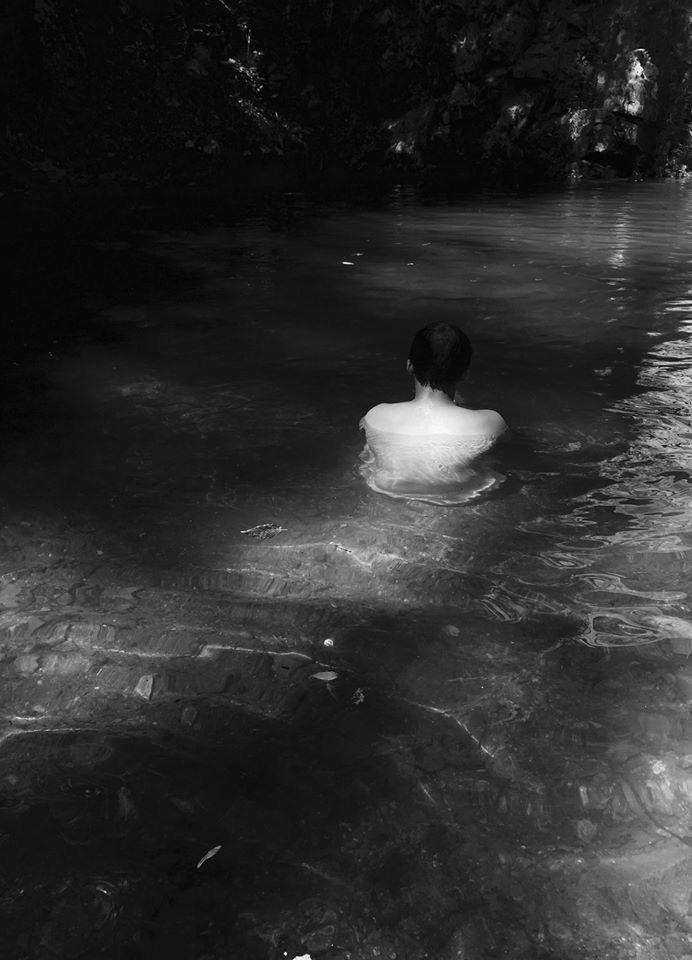
Photograph by Margot Kingon
When she stumbled across it, she didn’t think much of it. A photograph with little useful information. A photograph with nothing apparent to say about family history. A black and white photograph of a man crouched in the waters of a stream, rocks visible below the surface in the foreground, a darkness on the opposite bank in the background. She tossed it aside, favoring images with faces to recognize, her grandmother, her grandfather, her mother, her father, her aunts, her uncles. That is to say, portraits she recognized as the family history that had brought her to where she was in life.
She made a selection of those images and tucked them into an envelope to bring with her to the hospice. She wanted to provoke memories from her father, as many as she could before he left. She wanted to carry forward as much of the family history as possible, for her children, her children’s children, her children’s children’s children. She wanted to be able to speak the web of stories to them down through the ages, adding her own, inspiring them to add their own as they moved through space over time.
…
She walked through the door to her dad’s room. His eyes opened to the distinctive sound of his daughter’s entry. There wasn’t anything exceptionally noticeable about the way she moved through doors, but when you’ve known someone all their lives, you become familiar with their nuances. You sense them in all manner of ways you are barely aware of.
A smile spread across his face as she walked up to the bed.
Good timing he said, just finished a nap.
How are you feeling? she asked.
Better now that you’re here. What’s that? he said, glancing towards the envelope clutched to her chest.
Some of your pictures dad. I thought we could look at them together and you could tell me about them.
More family inquisition? he said with a half smile.
He understood his daughter’s need to plumb the past and gather what she could about his-story, which was, of course, part of her-story. He didn’t mind these sessions, though he was growing more weary each day as his body moved towards reintegration, as he liked to think about it.
She pulled the pictures out and they went through them, Who’s this? she asked, or, Tell me more about Aunt J or Where was this taken? or, Why does mom look sad in this one?
After a while she could see her father was getting tired, so she tucked the pictures back into the envelope, turning pictures already viewed the opposite direction from the ones not viewed so she could remember where they were tomorrow. He closed his eyes and drifted off to sleep. She sat in the chair beside his bed and listened to him breathe for a while, then she dosed off too. When she woke his eyes were focused on her. They smiled at one another.
Glancing at her watch she said I better go, gotta feed the dogs and Mark, Same time tomorrow?
I’ll be here.
Promise?
Promise!
She knew he would keep his promise if he could. She knew the hospice would call her if it looked like he wouldn’t.
…
When she got home Mark was waiting, dogs fed, diner ready. A Persian shrimp dish with basmati rice and bitter greens salad. She poured herself a glass of wine.
How’s your dad? he asked.
Good, we had a nice chat. I brought some of his pictures and we went through them. It was nice to hear his stories. I know most of them, but there is always something new.
How was your day? she asked.
Work is work, he said.
She considered his reply for a moment.
Thank you, she said.
For what? he asked.
For working, for being here, for giving me time with my dad.
Nothing you wouldn’t do for me, he said.
…
Days continued to pass. Her visits with her father became less conversational and more quiet communion as his energy flagged. His “reintegration” would be soon. She spent more of each day by his side, wanting to be sure he wasn’t alone, that she didn’t miss the final goodbye.
…
She came home briefly for a change of clothes. For some reason, she felt compelled to have another look through his photographs and the odd one, the ambiguous one, came to the top again, it posed so many questions. Why did he hold on to a photograph that seemed to have so little to say directly about how things were? She decided to bring it back with her. He spent little time awake or coherent at this point, but if he became lucid she thought she would ask about it. And there was a lucid moment. When it came, she raised the photograph up.
Can you tell me about this one? she asked.
His face came alive in a way she could only describe as beatific. The expression then faded away without a word uttered. Breath stopped shortly after. She would never know what the photograph meant to him. She would never forget his radiant smile.
She framed the photograph and hung it on her wall. It gave her peace to look at it and remember her father’s radiant smile.
Time continued to pass. She too grew old and frail. Her son visited often as she moved towards her reintegration. One day he asked her about the photograph on the wall, which seemed so ambiguous, about so little. A smile spread across her face, she told him about her father’s final moments, his radiant smile.
When she reintegrated, he brought the photograph home with him and hung it on the wall. It reminded him of her beautiful smile. He imagined the crouched figure of the man in the water as the cumulative spirits of all his ancestors. It gave him peace whenever he needed it.